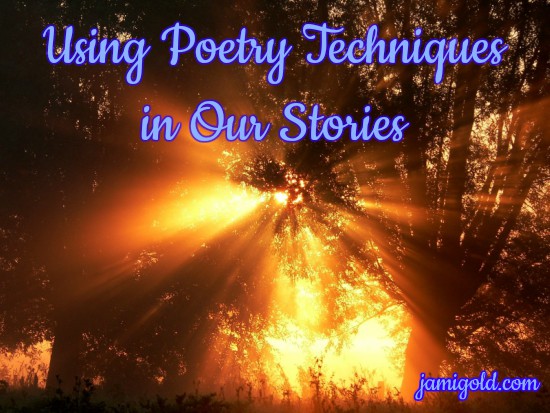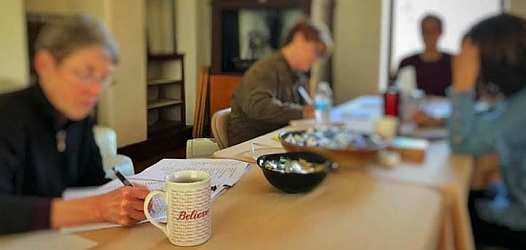Using Tips from Poetry to Strengthen Our Prose — Guest: Pamela Donison

Whether we’re novelists or short story writers, we’ve probably experienced the irony of how longer writing—such as our story—can sometimes be easier to write than something shorter, like a synopsis, query, Twitter pitch, or log line. The shorter we go, the more every word counts.
That’s why authors often turn to the skills important in poetry to strengthen our writing. In poetry, every word counts for rhythm, imagery, rhyming, etc., so poetry techniques can teach us a lot about how to improve our prose—word by word, line by line.
How can the techniques of poetry help us strengthen our prose? Click To TweetWe might pay attention to the rhythm of our words, or we might play with paragraph breaks—the prose version of “lining out” a poem. We might try to add more similes or metaphors or imagery, or we might dig into rhetorical devices.
But there’s another poetry technique we can add to our writing craft toolbox that we might not have thought of before. Pamela Donison, who offers writing retreats and mentoring for sparking creativity, is another one of the awesome guest posters filling in for me during NaNoWriMo, and she’s going to teach us how to apply poetry skills to our prose writing.
Please welcome Pamela Donison! *smile*
*****
Embroidering Your Prose Through Haiku
by Pamela Donison
Have you ever read something that was just okay, but didn’t really sing on the page? A sentence or paragraph (or a whole book?) that lacked the magic your reader’s mind was seeking?
You can avoid the lackluster reporting of events by “embroidering” your scenes with evocative imagery, applied with a spare hand and discerning eye. This is a perfect exercise for including sensory details that pull your reader into the scene, while leaving room for their imagination to fill in the rest of the picture.
Add Sensory Details with Techniques from Poetry
One of my passions is helping writers conjure that magic on the page via my creative writing retreats, where I help professional women discover the joy of writing something other than another memo. To get into the groove of creative writing, I use a meditative haiku exercise I learned from John Paul Lederach, American Professor of International Peacebuilding at the University of Notre Dame.
Once we’ve created haiku, I teach writers how to extract the imagery to embellish their prose. You can use this powerful exercise any time you need fresh inspiration to “embroider” sensory details onto your work.
7 Steps to Using Haiku Techniques in Our Prose
Step One: Learn the Rules of Haiku
As a reminder, haiku follows a strict 5/7/5 syllable format and, traditionally, was a sensory description of the natural world, often seasonal.
Here are three examples of haiku from Basho Matsuo (1644-1694), considered to be the greatest haiku poet:
An old silent pond…
A frog jumps into the pond,
splash! Silence again.
Autumn moonlight—
a worm digs silently
into the chestnut.
In the twilight rain
these brilliant-hued hibiscus –
A lovely sunset.
For some gorgeous examples of haiku, you can visit the archives of the Haiku Society of America (yep, that’s a thing!).
Step Two: Immerse Yourself
Start with a walking meditation, silently recording sensory input as you meander through the woods, on the beach, in a park, on a city sidewalk, or other environment that resembles the setting of your story.
Pay close attention to the sensations on your skin, the sounds around you, scents, colors, and even taste. Use this time as a mini-retreat of the mind, releasing your inner chatter, and soaking up the nuances of the world around you.
Step Three: Create a Key Word Dump
When you feel steeped in the voice of the environment, take about 15 minutes and dump all those lovely words on the page, by hand. These are your key words.
Here are some examples:
- Warm sun
- Cool air
- Crisp
- Crunching gravel
- Veins
- Moss
- Dark scat
- Gray branches
- Cooing doves
- Rough bark
- Scattered acorns
- Engine noise
Step Four: Create Phrases
Now that you have some key words in place, create some phrases that evoke the mood of your setting. Keep in mind the spare, clean lines of haiku as you develop your inspired phrases.
Here are some examples:
- Silver gray branches
- Sputtering engine
- Veins like river beds
- Kiss of sun
Step Five: Tie Your Phrases Together
Haiku follows a strict 5-7-5 rhythm. While it sounds restrictive and difficult, employing close boundaries can actually make us more creative, forcing us to use the most economical phrasing while still conveying a setting and a mood.
Here are some examples:
Sputter of engine
Cracks open the silent dawn
Anxious birds reply
Scattered acorns and
Silver gray branches yearning
For spring, impatient
Step Six: Embroider Your Prose
Now that you’ve plumped up your creativity, take a scene that you’re working on and start embroidering your prose with mood and sensory descriptions from your haiku.
For the sake of example, I’ve employed most of the words from the corresponding haiku, but you don’t have to use every description or phrase! The haiku is simply a vehicle to draw out your creative observations, which you can then include in your story.
- Before: Jason spotted Dori walking toward him.
- After: Just as he spotted Dori, the sputter of an engine cracked the silent dawn and anxious birds replied.
- Before: Dori tried to walk quietly toward Jason.
- After: Dori tiptoed, sheltered behind the silver-gray branches yearning for spring, but scattered acorns crunched loudly, and Jason turned as she approached.
Step Seven: Experiment!
Did you hit the mark? If not, don’t be discouraged! That’s what revisions are for.
Some reminders:
- Remember, less is more! Use this method sparingly. We don’t need to tell the reader every detail.
Small stitches of color here and there (just a bit of “embroidery”) can make a deep impact on the reader by giving them just enough to paint the scene in their mind.
- Haiku is just one vehicle.
You can use a sonnet, limerick, couplet, ballad, or quatrain.
Whatever strikes your writer’s heart and will encourage your Creative Spark is exactly perfect.
*****
 Pamela Donison is a writer, attorney, entrepreneur, and Oxford comma supporter. In addition to her day job as a family law attorney, Pamela is working on a murder mystery series. She also helps creatively frustrated professional women nurture their Creative Spark through exclusive writing retreats and 1:1 mentoring via www.UnBoundWriters.com
Pamela Donison is a writer, attorney, entrepreneur, and Oxford comma supporter. In addition to her day job as a family law attorney, Pamela is working on a murder mystery series. She also helps creatively frustrated professional women nurture their Creative Spark through exclusive writing retreats and 1:1 mentoring via www.UnBoundWriters.com
Pamela was an award winning journalist, feature writer, and editor in the U.S. Air Force. She later worked as a magazine editor, public affairs manager, and some pay-the-bills jobs, before landing a position as Acquisitions Editor for a small publishing house in Tucson, Arizona. A couple of years after the company was bought out by Harcourt Brace, she took her severance pay and went to law school, graduating from the University of Arizona James E. Rogers College of Law just a few weeks shy of her 40th birthday.
These days, Pamela splits her time between Vancouver, British Columbia, and Tucson, Arizona, with her husband and rescue mutt.
Visit her website to get snippets and special offers for Pamela’s upcoming mystery, Death Comes for Christmas!
*****
About UnBound Writers Creativity Camp:
As professionals, we know it’s bloody hard to break away for a few days off. And you never seem to have quiet time for writing. Why not do both?
Nourish your soul, rest your body, feed your mind, and nurture your Creative Spark — all in beautiful, sacred, natural spaces designed for renewal. This retreat is for professional women only, including business owners and retired women with a story to tell.
Creativity Camp is for:
- Complete Newbies — We cover the basics, including writing your premise, elements of story, and how to use the Pomodoro Technique to get thousands of words on the page quickly.
- WIP Women — We offer craft lessons to help you refine your work, including the Hero’s Journey, character development, and the revision process.
- All Levels — Nurture your Creative Spark with moving meditation, guided imagery, imaginative prompts, and sharing the Writer’s Life with like-minded women and free time for writing on your own.
Join Pamela and co-founder Shannon Bradley at Creativity Camp!
The next camp is scheduled for March 28-31, 2019, in Oracle, Arizona, at the amazing El Rancho Robles. Tuition includes lodging, meals, and all classes. Or check out the private UnBound Writers Facebook group for more information.
*****
Thank you, Pamela! I love this tip because haiku’s structure of 5 or 7 syllables per line automatically keeps each line as a little sprinkle of imagery. Then depending on our voice, we get to choose how many lines or sprinkles would make sense to thread into our prose. Perfect!
As Pamela said, a little bit can go a long way. Maybe we’d use only one line, spread the lines over several sentences or paragraphs, or use this technique just once a scene. It all depends on what’s right for our voice, our characters (and their point of view), and our story’s mood, tone, or style.
If we’re not sure when it would make sense to pull this technique out of our craft toolbox, we can keep in mind that where we use more words, we’re telling the reader something is important. So we might want to save this technique for sections where we want to emphasize the mood or emotions, slow down the pacing, or need more sensory details or setting information anyway.
Like many advanced skills, we probably wouldn’t worry about weaving in these imagery phrases until our editing phase. During drafting, our goal is usually just to get our story ideas down, and we can improve the actual words we use later.
As Pamela also pointed out, we can use this technique with other types of poetry than just with haiku. With all the options, hopefully, we can find a way to make this skill work for us. *smile*
Have you written in the haiku style? Or have you written other types of poetry before? Can you think of how to apply this technique to your writing or story? Do you have other insights about using poetry techniques to share? Do you have any questions for Pamela?
Pin It


Hey this is pretty cool! ? I don’t know much about Haikus, but I especially remember Ezra Pound’s “In a Station of the Metro”—what evocative imagery! Also, I like how haikus focus on one vivid detail at a time, which creates a very pleasant effect. Good tips about word dumps and gradually building it up too.